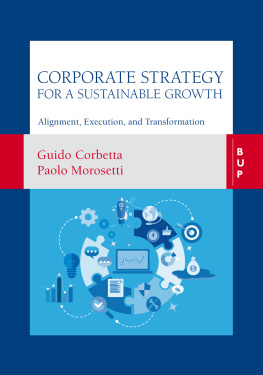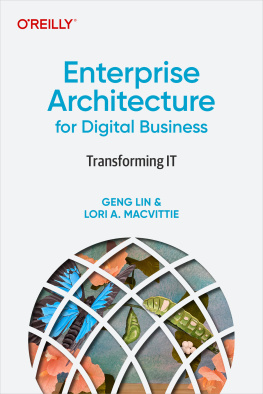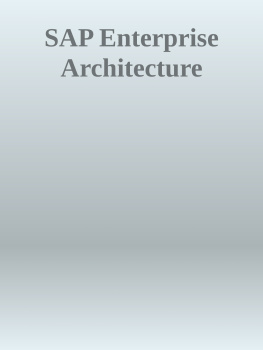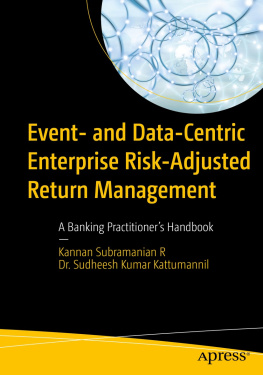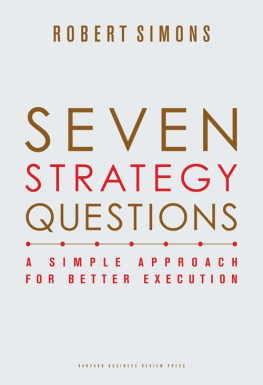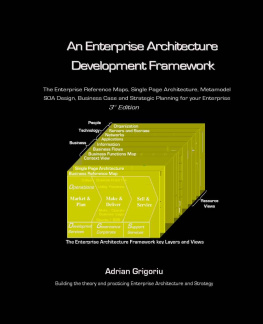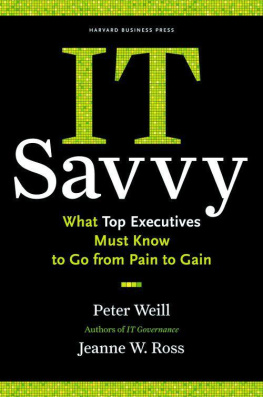Copyright 2006 Jeanne W. Ross, Peter Weill, and David C. Robertson
All rights reserved
No part of this publication may be reproduced, stored in or introduced into a retrieval system, or transmitted, in any form, or by any means (electronic, mechanical, photocopying, recording, or otherwise), without the prior permission of the publisher. Requests for permission should be directed to permissions@ hbsp.harvard.edu, or mailed to Permissions, Harvard Business School Publishing, 60 Harvard Way, Boston, Massachusetts 02163.
First eBook Edition: August 2006
ISBN: 978-1-4221-4817-4

Contents

In 1995 we started our study of enterprise architecturewe just didnt know it. At the time we thought we were studying information technology infrastructure transformations. In 1998 we thought we were studying enterprise system implementations. In 2000 it was e-business. But sometime in 2000, we recognized that each of these studies examined basically the same thing: enterprise architecture. We saw a pattern across those studies of what smart and profitable companies did differently. These companies made a commitment to a way of operating, and they were using IT to digitize that commitment. These companies kept getting better, faster, and more profitable at what they did while other companies were still figuring out what to do.
Most of the effort to define enterprise architecture has been located in companies IT units. But the historic ineffectiveness of IT architecture efforts in large organizations has troubled us for years. In presentations we have railed against traditional IT architecture efforts for their remoteness from the reality of the business and their heavy reliance on mind-numbing detail represented in charts that look more like circuit diagrams than business descriptions and that are useful as little more than doorstops. All three of us have been frustrated by our inability in our research and executive education to make a breakthrough in understanding and improving IT architecture efforts. Until now...
It is now clear our problem was the level of analysis. As Albert Einstein famously remarked, The significant problems we face cannot be solved by the same level of thinking that created them. The problem with our efforts to understand IT architecture was that the level of analysis was all wrong. The focus needs to be higheron enterprise architecture, the organizing logic for core business processes and IT infrastructure reflecting the standardization and integration of a companys operating model. We have come to understand that enterprise architecture boils down to these two concepts: business process integration and business process standardization. In short, enterprise architecture is not an IT issueits a business issue.
The breakthrough in our understanding lay in an apparent contradiction. In a business world that is changing faster than ever before, the top-performing firms create a stable basethey digitize their core processes and embed those processes into a foundation for execution. This stable foundation makes a company both more efficient and more agile than its competitors. With global supply chains, pressure for ever faster time to market, more complex regulation, and huge shifts in customer demographics and desires, companies cannot predict the future. But they can decide what makes them great. And then they can create a low-cost, high-quality core of stability and constancy in a turbulent world. With a strong digitized core, great companies slide smoothly into the next opportunity while their competitors stumble.
Top-performing companies define how they will do business (an operating model) and design the processes and infrastructure critical to their current and future operations (enterprise architecture), which guide the evolution of their foundation for execution. Then these smart companies exploit their foundation, embedding new initiatives to make that foundation stronger, and using it as a competitive weapon to seize new business opportunities. And what makes this capability a competitive advantage is that only a small percentage of companies do it wellwe estimate 5 percent of firms or less.
The objective of this book is to structure and explain what top-performing companies do so others can follow and improve. To inspire and illustrate what works well, we provide many examples of outstanding companies, including 7-Eleven Japan, CEMEX, Dow Chemical, ING DIRECT, MetLife, Schneider National, Toyota Motor Europe, UNICEF, UPS, and others. This book is about what makes a company great. Ultimately, of course, people make the difference. Good people design the operating model, build the foundation, execute, and innovate. But good people need direction, leadership, and incentives to perform at their best. This book is for managers, both business and IT, who sense the business problem and want to lead their organizations to build a solutiona unique digitized foundation for execution for their company.
The Research
The insights in the book come from a series of research projects exploring enterprise architecture in more than 200 companies (and another 256 companies where our focus was on IT governance) from 1995 to 2005. Most of the research was done at the MIT Sloan Schools Center for Information Systems Research (CISR); the European work was done by David Robertson at IMD. The main studies were:
- Case studies of eighteen firms implementations of new infrastructure capabilities, enterprise resource planning systems, and e-business initiatives by Jeanne Ross, Michael Vitale, and Peter Weill between 1995 and 2005. The cases focused on transformations leading toand in some cases driven bynew IT capabilities. Companies included Australia Post, Brady Corp., Chase Manhattan, the District of Columbias city government, Dow Corning, GTECH, JC Penney, Johnson & Johnson, Manheim Auctions, MetLife, Schneider National, Texas Instruments, Travelers, and five others.
- Case studies at eight companies on the relationship between IT and business strategy by Jeanne Ross and Peter Weill during 2001 and 2002. We studied how firms developed IT capabilities in response to business strategy. We also looked at how IT units were developing and managing enterprise architecture. Companies included Air Products and Chemicals, Citibank Asia Pacific, Delta Air Lines, DuPont, Merrill Lynch, Nestl USA, Toyota USA, and UPS.
- Case studies on enterprise architecture at sixteen companies in the United States and Europe by David C. Robertson, Jeanne Ross, George Westerman, and Nils O. Fonstad in 2002. We studied how IT architecture enabled and constrained business initiatives. We also looked at how companies defined and managed business and technology standards. Cases were based on interviews with the CIO, IT architect, two project heads, and others at Akzo Nobel, BIC Graphic Europe, BT, Campbell Soup Co., Canon Europe, Carlson Companies, ING DIRECT, Marriott, Novartis, Panalpina, Partners HealthCare, Pfizer, Scheron, Swisscom Mobile, Tetra Pak, and Toyota Motor Marketing Europe.
- Surveys of 103 firms to assess architecture outcomes by Jeanne Ross and Nils O. Fonstad in 2004. We examined IT investments, architecture management practices, architecture maturity, and IT and business outcomes.
- Surveys of eighty firms IT and business process outsourcing initiatives by Jeanne Ross and Cynthia Beath in 2004 in conjunction with Lorraine Cosgrove at CIO Magazine . We examined the services outsourced, the characteristics of those services, the vendor-client relationship, architecture implications, and outcomes.
- Case studies of architectural implications of outsourcing at eight firms by Jeanne Ross, Cynthia Beath, Jeff Sampler, and Nils O. Fonstad during 2004 and 2005. We studied the role of enterprise architecture in outsourcing decisions and outcomes. The companies were Campbell Soup Co., Carlson Companies, Dow Chemical, eFunds, JM Family Enterprises, Tecnovate, and two others.
Next page


